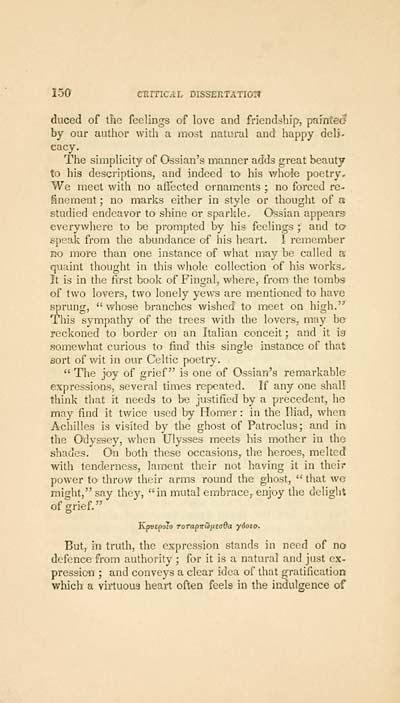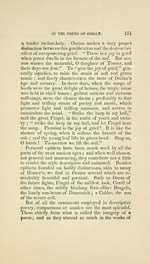Ossian Collection > Poems of Ossian
(158)
Download files
Complete book:
Individual page:
Thumbnail gallery: Grid view | List view

150 CRITICAI, DISSErtTATIOH
duced of the feelings of love and friendship, painted
by our authar with a most natural and happy delj.
cacy.
The simplicity of Ossian's manner adds great beauty
to his descriptions, and indeed to his whole poetry.
We meet with no affected oi'naments ; no forced re-
finement ; no marks either in style or thought of a
studied endeavor to shine or sparkle. Ossian appears-
everywhere to be prompted by his feelings ; and to
speak from the abundance of his heart. I remember
no more than one instance of what may be called a
quaint thought in this whole collection of his works.
It is in the first book of Fingal, where, fronrj the tombs
of two lovers, two lonely yews are mentioned to have
sprung, "whose branches wished to meet on high."
This sympathy of the trees with the lovers, may be
reckoned to border on an Italian conceit ; and it ia
somewhat curious to find this single instance of that
sort of wit in our Celtic poetry.
" The jay of grief" is one of Ossian's remarkable
expressions, several times repeated. If any one shall
think that it needs to be justified by a precedent, he
may find it twice used by Homer : in the Iliad, when
Achilles is visited by tlie ghost of Patroclus; and in
the Odyssey, when Ulysses meets his mother in the
shades. On both these occasions, the heroes, melted
with tenderness, lanrrent their not having it in their
power to throw their arms round the ghost, " that we
might," say they, "in mutal embrace, enjoy the delight
of grief."
Kpvtpoto rorapitdjitada ydoio.
But, in truth, the expression stands in need of na
defence from authority ; for it is a natural and just ex-
pression ; and conveys a clear idea of that gratification
which a virtuous heart often feels in the indulgence of
duced of the feelings of love and friendship, painted
by our authar with a most natural and happy delj.
cacy.
The simplicity of Ossian's manner adds great beauty
to his descriptions, and indeed to his whole poetry.
We meet with no affected oi'naments ; no forced re-
finement ; no marks either in style or thought of a
studied endeavor to shine or sparkle. Ossian appears-
everywhere to be prompted by his feelings ; and to
speak from the abundance of his heart. I remember
no more than one instance of what may be called a
quaint thought in this whole collection of his works.
It is in the first book of Fingal, where, fronrj the tombs
of two lovers, two lonely yews are mentioned to have
sprung, "whose branches wished to meet on high."
This sympathy of the trees with the lovers, may be
reckoned to border on an Italian conceit ; and it ia
somewhat curious to find this single instance of that
sort of wit in our Celtic poetry.
" The jay of grief" is one of Ossian's remarkable
expressions, several times repeated. If any one shall
think that it needs to be justified by a precedent, he
may find it twice used by Homer : in the Iliad, when
Achilles is visited by tlie ghost of Patroclus; and in
the Odyssey, when Ulysses meets his mother in the
shades. On both these occasions, the heroes, melted
with tenderness, lanrrent their not having it in their
power to throw their arms round the ghost, " that we
might," say they, "in mutal embrace, enjoy the delight
of grief."
Kpvtpoto rorapitdjitada ydoio.
But, in truth, the expression stands in need of na
defence from authority ; for it is a natural and just ex-
pression ; and conveys a clear idea of that gratification
which a virtuous heart often feels in the indulgence of
Set display mode to: Large image | Transcription
Images and transcriptions on this page, including medium image downloads, may be used under the Creative Commons Attribution 4.0 International Licence unless otherwise stated. ![]()
| Early Gaelic Book Collections > Ossian Collection > Poems of Ossian > (158) |
|---|
| Permanent URL | https://digital.nls.uk/81252423 |
|---|
| Description | Selected books from the Ossian Collection of 327 volumes, originally assembled by J. Norman Methven of Perth. Different editions and translations of James MacPherson's epic poem 'Ossian', some with a map of the 'Kingdom of Connor'. Also secondary material relating to Ossianic poetry and the Ossian controversy. |
|---|
| Description | Selected items from five 'Special and Named Printed Collections'. Includes books in Gaelic and other Celtic languages, works about the Gaels, their languages, literature, culture and history. |
|---|

